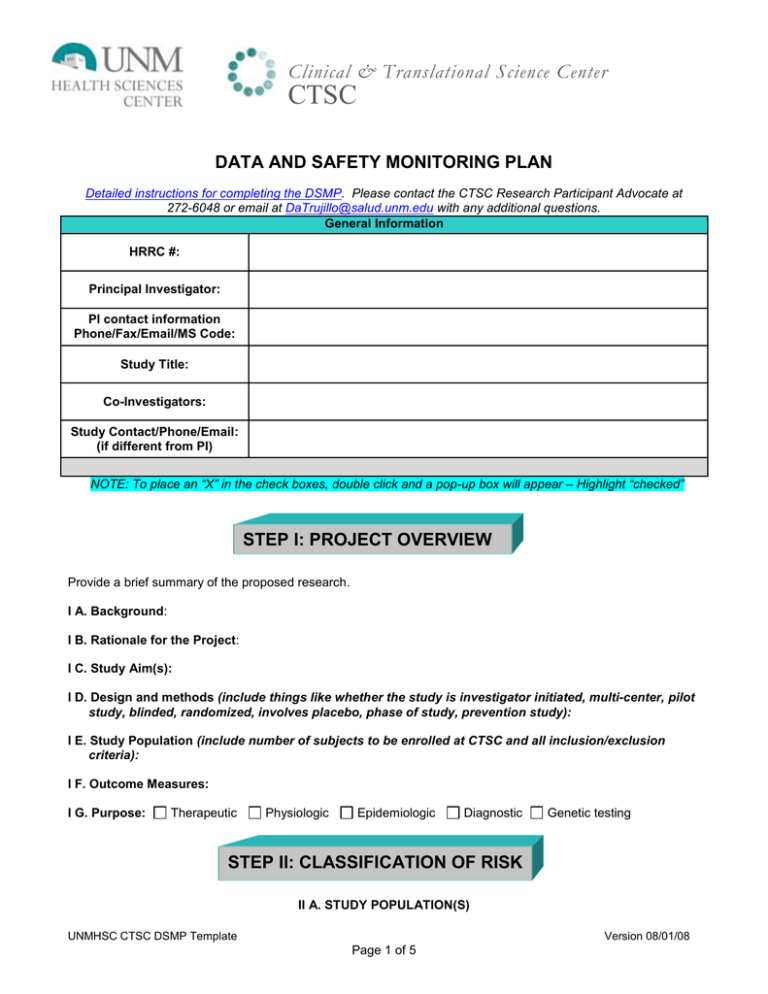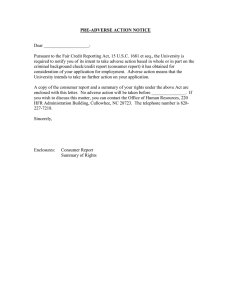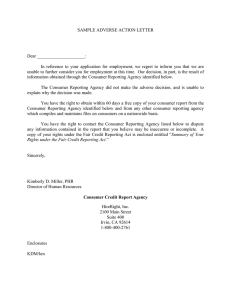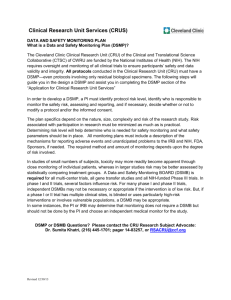CTSC Clinical & Translational Science Center DATA AND SAFETY MONITORING PLAN
advertisement

Clinical & Translational Science Center CTSC DATA AND SAFETY MONITORING PLAN Detailed instructions for completing the DSMP. Please contact the CTSC Research Participant Advocate at 272-6048 or email at DaTrujillo@salud.unm.edu with any additional questions. General Information HRRC #: Principal Investigator: PI contact information Phone/Fax/Email/MS Code: Study Title: Co-Investigators: Study Contact/Phone/Email: (if different from PI) NOTE: To place an “X” in the check boxes, double click and a pop-up box will appear – Highlight “checked” STEP I: PROJECT OVERVIEW Provide a brief summary of the proposed research. I A. Background: I B. Rationale for the Project: I C. Study Aim(s): I D. Design and methods (include things like whether the study is investigator initiated, multi-center, pilot study, blinded, randomized, involves placebo, phase of study, prevention study): I E. Study Population (include number of subjects to be enrolled at CTSC and all inclusion/exclusion criteria): I F. Outcome Measures: I G. Purpose: Therapeutic Physiologic Epidemiologic Diagnostic Genetic testing STEP II: CLASSIFICATION OF RISK II A. STUDY POPULATION(S) UNMHSC CTSC DSMP Template Version 08/01/08 Page 1 of 5 Check off all characteristics that apply to all study groups (i.e., experimental groups and control groups) Study Population(s) Adult Populations Vulnerable Populations Seriously Ill/High Risk Populations Over age 18 Children Premature infants/VLBW/ELBW Healthy volunteers Cognitively impaired Patients in ICU High risk (> 5%) of serious adverse Not pregnant Economically or educationally disadvantaged events from an underlying condition Specify Condition: Students/staff/employees Cancer Pregnant women/Fetuses Immune-compromised Prisoners End-Stage Renal Disease Targeted or limited to specific Attribution of adverse events may be ethnic group(s) difficult II B. RESEARCH PROCEDURES AND INTERVENTIONS Enter each procedure or intervention that will be performed during the research as well as the level of risk associated with it (Use Procedure/Intervention Risk Classification List as a reference guide) Research Procedures and Interventions Procedure being done for research purposes Risk level for subject (mark appropriate column) Minimal/Low Moderate High II C. OVERALL RISK CLASSIFICATION Indicate your overall assessment of risk classification by placing a check mark next to ‘Low’, ‘Moderate’, or ‘High’. Describe any factors that affect your determination of the overall risk, taking in to consideration the highest marked risk for the study population, procedure(s), or intervention(s). Overall Risk Classification PI’s Overall Assessment of Risk Level: Minimal Risk Low Risk Moderate Risk High Risk PI rationale for Overall Risk Classification: STEP III: ADVERSE EVENTS III A. ANTICIPATED ADVERSE EVENTS Indicate any anticipated adverse events that could potentially occur during participation in the research study and up to 30 days after completion of study participation. Please indicate whether each event is: (a) serious, (b) research related or (c) related to the participant’s underlying condition. UNMHSC CTSC DSMP Template Version 08/01/08 Page 2 of 5 Adverse Event Anticipated Adverse Events Serious Related to the Adverse Research? Event? Yes No Yes No Yes No Yes No Yes No Yes No Yes No Yes No Yes No Yes No Yes No Yes No Related to the Underlying Condition? III B. MONITORING ADVERSE EVENTS Place a check mark next to each method that will be used to monitor for adverse events. Use “Other Monitoring Procedures” to indicate monitoring procedures not included here. Please indicate the frequency with which each monitoring method will be performed (e.g., each visit, continuously, hourly, daily, weekly, monthly, annually, and so on). Monitoring Adverse Events Subject Report Frequency Safety Labs Frequency Spontaneous subject report Chemistry panel Subject diary Pregnancy test Subject interview CBC w/differential Other: (specify): Other: (specify): Periodic Observations Vital signs ECG Medical record review Chest X-ray Other (specify): Study Visit Monitoring Personnel Principal Investigator Co-Investigator (specify) Study Coordinator(specify) CTSC Nurses - Inpatient, Outpatient, or Scatterbed (circle one) Frequency Frequency Continuous Monitoring Heart rate Respiration rate Oxygen saturation Blood pressure Other: (specify): Other Monitoring Procedures Frequency Frequency III C. GRADING ADVERSE EVENTS There are several standardized scales designed for disease-specific trials to grade AEs by severity. These scales may also be applicable to other studies, but may not be appropriate for all studies. In the event that a standardized scale is not appropriate for a particular study, the PI should indicate a more appropriate grading scale that will be used to evaluate the severity of adverse events. Check the grading scale that will be used to grade the severity of any adverse events. Grading Adverse Events Adverse Events in Adults Common Terminology Criteria for Adverse Events (CTCAE, v 3.0) - Cancer Therapy Evaluation Program (CTEP) CTCAE v.3.0 UNMHSC CTSC DSMP Template Version 08/01/08 Page 3 of 5 Adverse Events in Newborns Under 3 Months of Age NIH National Institute of Allergy and Infectious Diseases, Division of AIDS Toxicity Tables Pediatric Toxicity Table < 3 months.pdf Adverse Events in Children and Newborns Over 3 Months of Age) NIH National Institute of Allergy and Infectious Diseases, Division of AIDS Toxicity Tables Pediatric Toxicity Table > 3 months.pdf Other standardized grading scale. Specify (or attach paper/electronic copy): III D. REPORTING ADVERSE EVENTS Place a check mark in all appropriate columns to indicate all entities to which AE reports will be submitted. Reporting Adverse Events NIH Institute (specify): CTSC RPA Office HRRC Indian Health Service (IHS) IRB Sponsor (specify): Navajo IRB Other Tribal IRB or Council (specify): FDA Independent Monitor VA Research and Development Committee Data and Safety Monitoring Board/Committee Other (specify): STEP IV: SAFETY AND EFFICACY REVIEW IV A. DATA FOR INTERIM SAFETY AND EFFICACY REVIEW Annual Review of the following data are REQUIRED by HRRC and CTSC: 1) The number of participants screened, 2) The number of participants enrolled, 3) The number of participants that withdraw or are withdrawn, 4) Adverse events, and 5) Protocol violations/deviations. In the table below, indicate what data will be submitted for interim safety and efficacy review (check all that apply): Data for Interim Safety and Efficacy Review Interim Safety Review Interim Efficacy Review Safety labs/data Primary outcome indicators (specify): Research-related adverse events Secondary outcome indicators (specify): Additional safety data (specify) IV B. FREQUENCY OF INTERIM SAFETY AND EFFICACY REVIEW Indicate the time intervals when interim safety/efficacy review will occur. If different data will be reviewed at different intervals, please provide brief details of the schedule. Frequency of Interim Safety and Efficacy Review After every subjects enrolled Every 12 months (At the time of HRRC renewal) Every 6 months – starting date: After subjects, then (specify) Every 3 months - starting date: Other (specify): IV C. CRITERIA FOR PROTOCOL REVISION OR STUDY SUSPENSION Specify any safety and efficacy outcomes defined in the protocol which would indicate a need to amend the protocol or to discontinue one or more arms of the protocol (i.e. unanticipated events, early demonstration of efficacy, inferiority, or futility where the results will not confirm nor reject the hypothesis, etc.)? (NOTE: This does not refer to withdrawing single subjects) Criteria For Study Suspension IV D. SAFETY AND EFFICACY REVIEW PERSONNEL UNMHSC CTSC DSMP Template Version 08/01/08 Page 4 of 5 Indicate who will review the study (check all that apply) and what role they will have in the review (e.g., review AE reports, analyze safety data, interim efficacy analysis). Safety and Efficacy Review Personnel Review Review enrollment individual Reviewer(s) data AE reports CTSC Research Participant Advocate Periodic safety analysis Periodic efficacy analysis HRRC Principal Investigator Committee of PI/Co-investigators/Research Team Independent Monitor (Name): Email Address: DSMB or DSMC (Attach DSMB Roster and Charter*) Other (specify): *A DSMB Roster is a list of DSMB members including each member’s name, credentials, affiliations, and role on the DSMB. A DSMB Charter, also called a Constitution or Standard Operating Procedure is a description of specific activities, procedures, methods, and decision criteria that the DSMB will use in it’s review of safety and efficacy data. If a DSMB is necessary based on the overall risk determination, it is the principal investigator’s responsibility to ensure that an independent board is created to monitor the research. DSMB ROSTER (may attach separate list) 1) Chair Name/Credentials: Affiliation: 2) Member Name/Credentials: Affiliation: 3) Member Name/Credentials: Affiliation: 4) Member Name/Credentials: Affiliation: 5) Member Name/Credentials: Affiliation: UNMHSC CTSC DSMP Template Version 08/01/08 Page 5 of 5


